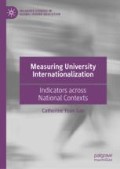Abstract
This chapter presents the first nation-based discussion on university internationalization. Through the eyes of Chinese university leaders, China’s cases illustrate the ways in which a nation’s economic and cultural features can shape universities’ approach to internationalization. Together with the national economy’s advancement in recent decades and improved research capacity, universities in China are striving for an equal position in international collaborations. Although they were comfortable playing a follower role in their international development in past decades because of a lack of confidence and capacity, today’s Chinese universities, particularly the top ones, are sufficiently confident to initiate and lead transnational agendas. This confidence comes from both the economy and the culture.
Access this chapter
Tax calculation will be finalised at checkout
Purchases are for personal use only
Notes
- 1.
Data source: Ministry of Education of the People’s Republic of China (2017). In 2017, the number of students studying abroad and returning to China increased simultaneously. Available at http://www.moe.edu.cn/jyb_xwfb/gzdt_gzdt/s5987/201803/t20180329_331771.html.
- 2.
In 2017, the Chinese government introduced a project to establish world-class universities and world-class disciplines by the end of 2050. The full list of the sponsored universities and disciplines was published in September 2017, which includes 42 first-class universities (36 Class A schools and 6 Class B schools) and 465 first-class disciplines (spread among 140 schools including the first-class universities).
- 3.
The One Belt, One Road initiative was proposed by the Chinese government in 2013 with the aim to enhance regional connectivity and embrace a brighter future. In 2016, the Ministry of China, P.R.C. launched the Promoting the One Belt, One Road initiative—Educational Action. The Action intends to strengthen educational communication and collaboration among countries included in the initiative, and to further develop China as a leading educational provider.
- 4.
Data source: Ministry of Education of the People’s Republic of China (2017). In 2017, the number of students studying abroad and returning to China increased simultaneously. Available at http://www.moe.edu.cn/jyb_xwfb/gzdt_gzdt/s5987/201803/t20180329_331771.html.
- 5.
Data source: Scimago Journal & Country Rank. Available at https://www.scimagojr.com/countryrank.php.
- 6.
In 2009, Peking University, Tsinghua University, Fudan University, Shanghai Jiao Tong University, Nanjing University, University of Science and Technology of China, Zhejiang University, Xi’an Jiao Tong University, and Harbin Institute of Technology formalized an elite group to foster better students, sharing their resources. This group is called the C9 League, as known as China’s Ivy League.
- 7.
The draft indicator list was developed based on the interview findings of all 17 universities across the three countries. Therefore, participants from different universities were presented with the same list of indicators. The analysis of responses was conducted by country first to generate the tailored indicator set for each country, and later a cross-country analysis was undertaken to generate the comparable indicator list for using across national boundaries. The results of cross-country data analysis were documented in Chapter 8. The questionnaire can be found in Appendix A.
References
Bi, J. J., & Huang, X. J. (2010). The challenges and strategies of internationalization of Chinese universities. Reform and Development, 1, 11–16 (in Chinese).
Gide, E., Wu, M. X., & Wang, X. P. (2010). The influence of internationalisation of higher education: A Chinese study. Procedia Social and Behavioral Sciences, 2(2), 5675–5681.
Hou, J. X., Montgomery, C., & McDwell, L. (2011). Transition in Chinese-British higher education articulation programmes: Closing the gap between East and West. In J. Ryan (Ed.), China’s higher education reform and internationalisation (pp. 104–119). Abingdon, Oxon and New York: Routledge.
Huang, F. (2003). Policy and practice of the internationalization of higher education in China. Journal of Studies in International Education, 7(3), 225–240.
Huang, F. (2007). Internationalisation of higher education in the era of globalisation: What have been its implications in China and Japan? Higher Education Management and Policy, 19(1), 47–61.
Liao, J. Q., Tan, G. X., & Zhu, X. G. (2008). Internationalization and localization of China’s higher education. Journal of Higher Education Management, 2(2), 1–7 (in Chinese).
Liu, D. Y. (2007). The choices and strategies for internationalisation of higher education. Journal of Higher Education Policy and Management, 28(4), 6–10 (in Chinese).
Ministry of Education, P.R.C. (2013a). China-foreign cooperative education programmes. Retrieved 23 March 2012, from http://edu.people.com.cn/n/2013/0314/c1053-20789582.html.
Ministry of Education, P.R.C. (2013b). Statistics of Chinese students studying overseas and the returnees. Retrieved 23 March 2012, from http://news.xinhuanet.com/overseas/2013-03/07/c_124429518.html.
Tan, Z. (2009). Internationalization of higher education in China: Chinese-foreign cooperation in running schools and the introduction of high-quality foreign educational resources. International Education Studies, 2(3), 166–170.
Wang, Y. B. (2008). Internationalization in higher education in China: A practitioner’s reflection. Higher Education Policy, 21(4), 505–517.
Welch, A., & Cai, H. X. (2011). The internationalisation of China’s higher education system. In J. Ryan (Ed.), China’s higher education reform and internationalisation (pp. 9–33). Abingdon, Oxon and New York: Routledge.
Yang, F. L., Liu, J. L., Dong, Y. Z., & Xu, R. (2011). Trend and policy study of internationalization of higher education in China. Journal of Tianjin University (Social Science), 13(3), 279–283 (in Chinese).
Yang, M., Xia, D. J., & Yang, Q. N. (2009). The political and cultural factors in the internationalization process of Chinese higher education: The import of foreign textbooks. Journal of Jinzhong University, 5, 77–81 (in Chinese).
Yang, R. (2002). Third delight: The internationalization of higher education in China. New York and London: Routledge.
Yang, R. (2010). Chinese ways of thinking in the transformation of China’s higher education system. In J. Ryan (Ed.), China’s Higher Education Reform and Internationalisation (pp. 34–47). Hoboken: Taylor & Francis.
Zhang, H. S. (2010). Higher education reforms and problems in China: Challenges from globalization. In F. Maringe & N. Foskett (Eds.), Globalisation and internationalisation in higher education: Theoretical, strategic and management perspectives (pp. 125–137). London: Continuum.
Author information
Authors and Affiliations
Rights and permissions
Copyright information
© 2019 The Author(s)
About this chapter
Cite this chapter
Gao, C.Y. (2019). China. In: Measuring University Internationalization. Palgrave Studies in Global Higher Education. Palgrave Macmillan, Cham. https://doi.org/10.1007/978-3-030-21465-4_4
Download citation
DOI: https://doi.org/10.1007/978-3-030-21465-4_4
Published:
Publisher Name: Palgrave Macmillan, Cham
Print ISBN: 978-3-030-21464-7
Online ISBN: 978-3-030-21465-4
eBook Packages: EducationEducation (R0)

